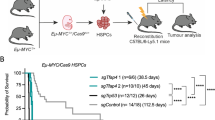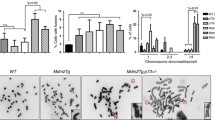Abstract
Burkitt's lymphomas (BL) are characterized by the constitutive expression of c-Myc protein. In total, 50–60% of all BL cells carry mutant c-Myc proteins. Using a mouse model of spontaneously immortalized pro-B-lymphocytes (Ba/F3), we have investigated genomic instability mediated by the conditional expression of either wild-type (WT) or deletion box II Δ106-Myc proteins. We found that both proteins mediate common as well as differing types of chromosomal rearrangements as documented by spectral karyotyping (SKY). A higher level of genomic instability is induced by the Δ106-Myc protein. To examine the tumorigenic potential of WT or Δ106-driven Ba/F3 cells, in vivo tumorigenesis studies were performed in SCID mice. Under the experimental conditions of this study, WT but not Δ106-Myc expressing Ba/F3 cells triggered tumorigenesis in SCID mice. Therefore, the genomic instability phenotype induced by Δ106-Myc can be genetically uncoupled from its tumorigenic potential.






Similar content being viewed by others
References
Amin C, Wagner AJ and Hay N . (1993). Mol. Cell. Biol., 13, 383–390.
Bhatia K, Huppi K, Spangler G, Siwarski D, Iyer R and Magrath I . (1993). Nat. Genet., 5, 56–61.
Chang DW, Claassen GF, Hann SR and Cole MD . (2000). Mol. Cell. Biol., 20, 4309–4319.
Conzen SD, Gottlob K, Kandel ES, Khanduri P, Wagner AJ, O'Leary M and Hay N . (2000). Mol. Cell. Biol., 20, 6008–6018.
Fest T, Mougey V, Dalstein V, Hagerty M, Milette D, Silva S and Mai S . (2002). Oncogene, 21, 2981–2990.
Fukasawa K, Wiener F, Vande Woude GF and Mai S . (1997). Oncogene, 15, 1295–1302.
Gaidano G, Pasqualucci L, Capello D, Berra E, Deambrogi C, Rossi D, Larocca LM, Glghini A, Carbone A and Dalla-Favera R . (2003). Blood, 102, 1833–1841.
Goruppi S, Gustincich S, Brancolini C, Lee WM and Schneider C . (1994). Oncogene, 9, 1537–1544.
Klein G . (1986). AIDS Res., 2 (Suppl 1), S167–S176.
Kumagai H, Mukaisho K, Sugihara H, Bamba M, Miyashita T, Miwa K and Hattori T . (2003). Scand. J. Gastroenterol., 38, 687–692.
Kuttler F, Ame P, Clark H, Haughey C, Mougin C, Cahn JY, Dang CV, Raffeld M and Fest T . (2001). Oncogene, 20, 6084–6094.
Lee TC, Li L, Philipson L and Ziff EB . (1997). Proc. Natl. Acad. Sci. USA, 94, 12886–12891.
Li LH, Nerlov C, Prendergast G, MacGregor D and Ziff EB . (1994). EMBO J., 13, 4070–4079.
Littlewood TD, Hancock DC, Danielian PS, Parker MG and Evan GI . (1995). Nucleic Acids Res., 23, 1686–1690.
Mai S and Mushinski JF . (2003). J. Environ. Pathol. Toxicol. Oncol., 22, 179–199.
Marhin WW, Chen S, Facchini LM, Fornace Jr AJ and Penn LZ . (1997). Oncogene, 14, 2825–2834.
Nesbit CE, Tersak JM and Prochownik EV . (1999). Oncogene, 18, 3004–3016.
Oster SK, Mao DY, Kennedy J and Penn LZ . (2003). Oncogene, 22, 1998–2010.
Pasqualucci L, Meumeister P, Goossens T, Nanjangud G, Chaganti RSK, Küppers R and Dalla-Favera R . (2001). Nature, 412, 341–346.
Raffeld M, Yano T, Hoan AT, Lewis B, Clark HM, Otsuki T and Dang CV . (1995). Curr. Top. Microbiol. Immunol., 194, 265–272.
Stone J, De Lange T, Ramsay G, Jakobovits E, Bishop JM, Varmus H and Lee W . (1987). Mol. Cell. Biol., 7, 1697–1709.
Acknowledgements
We thank Drs Michael Mowat and Konrad Huppi for stimulating discussions and Ms Mary Cheang for statistical analysis. This work was supported by grants from the Ligue Contre le Cancer comité du Doubs and the Fondation de France, Paris (TF), the Canada Foundation Innovation (CFI) (SM), the Canadian Institutes for Health Research (CIHR) (SM), and The National Science and Engineering Research Council (NSERC) (SM).
Author information
Authors and Affiliations
Corresponding authors
Rights and permissions
About this article
Cite this article
Fest, T., Guffei, A., Williams, G. et al. Uncoupling of genomic instability and tumorigenesis in a mouse model of Burkitt's lymphoma expressing a conditional box II-deleted Myc protein. Oncogene 24, 2944–2953 (2005). https://doi.org/10.1038/sj.onc.1208467
Received:
Revised:
Accepted:
Published:
Issue Date:
DOI: https://doi.org/10.1038/sj.onc.1208467
- Springer Nature Limited




